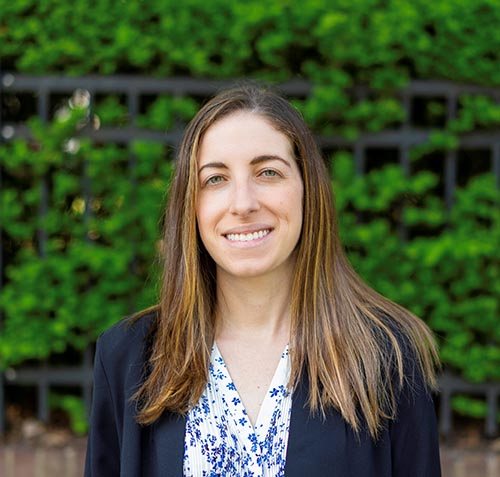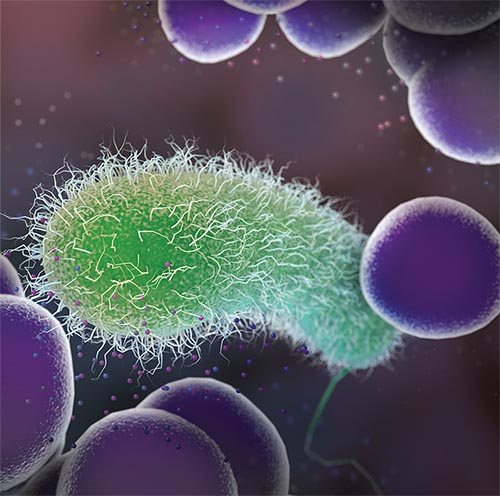Postdoc Profile: Eavesdropping On Bacterial Banter
Dr. Tiffany Zarrella Examines Communication Between Bacteria to Combat Persistent Infections

Dr. Tiffany Zarrella
Facebook’s nearly 3 billion users may seem like a huge social network, but it pales in comparison to the conversations among the trillions of microbes that live inside a single human body. Few people know this better than IRP postdoctoral fellow Tiffany Zarrella, Ph.D., who spends her days eavesdropping on the messages bacteria send to one another to improve treatment for stubborn infections.
Dr. Zarrella was drawn to the bacterial world in microbiology lab courses while earning a biochemistry degree at Syracuse University in New York. After graduation, she obtained a research technician position at Albany Medical College, where she worked on projects centered around infectious bacteria and how they respond to their environments. She continued this thread of research in graduate school, moving on to a new study to discover how Streptococcus pneumoniae bacteria, which often cause ear infections and pneumonia, use a particular signaling molecule to resist antibiotic treatments and evade vaccines.
“Bacteria have a fascinating world of their own,” she says. “There are some amazing aspects of bacterial biology that people do not immediately notice and realize.”
Now a postdoctoral fellow at NIH, Dr. Zarrella continues to parse the mysterious behavior of bacteria. One of the major questions she is exploring alongside her colleagues in the lab of IRP Stadtman investigator Anupama Khare, Ph.D., is how different bacterial species communicate with one another. She has been specifically focusing on two bacterial species, Staphylococcus aureus and Pseudomonas aeruginosa, that are commonly found together in the lung infections that plague people with cystic fibrosis, a rare genetic disease that causes breathing difficulties. In these patients, Pseudomonas aeruginosa often forms an impenetrable, mesh-like complex called a biofilm, which helps the bacteria shrug off antibiotics. By interrogating the bacterial messages that Staphylococcus aureus and Pseudomonas aeruginosa send to each other, Dr. Zarrella hopes to unlock clues that could help doctors get rid of them.

Image credit: Erina He, NIH Medical Arts
Pseudomonas aeruginosa (green) surrounded by signaling molecules released by Staphylococcus aureus (purple spheres).
“We found a collection of different signals being sent between these two species, like a conversation occurring between them through these signaling molecules,” she says. “Some of these signals are cooperative or beneficial, and some are competitive, putting them at odds with each other.”
Among all the signals these two bacterial species send to each other, Dr. Zarrella and her colleagues found one unique interaction particularly intriguing. Both species produce similar molecules that help them take up zinc from their surroundings, which is essential for their survival. When Staphylococcus bacteria produce a lot of their molecule and use up most of the zinc in their environment, the Pseudomonas bacteria respond by aggressively producing their own molecule to grab some of the zinc for themselves. Importantly, the molecule produced by Staphylococcus also blocks Pseudomonas from forming a biofilm, in which they make a protective barrier that promotes their survival. Dr. Zarrella believes that this competitive crosstalk could be leveraged in order to inhibit the growth of Pseudomonas and eliminate the stubborn, antibiotic-resistant infections it causes.
“It is important to identify these types of signaling molecules to create new antimicrobials, which could specifically target those pathways which control bacterial infections,” she says, which is why she wants to continue working to identify more of these signals. “It is nice to listen in on the bacteria talking to each other, but the major task ahead is to see how the bacteria respond to these conversations. It is somewhat like piecing together a puzzle, unraveling the bigger picture, and this is what I aim to work towards for the next couple of years.”
Hear Dr. Zarrella talk about her research in this NIH SciBites video.
For Dr. Zarrella, one of the main challenges of her work is the difficulty of studying bacteria in their native environments. Bacteria are mostly found in multi-species communities, where they have evolved together, and re-creating these complex conditions in the lab is an arduous task. As a result, Dr. Zarrella is also working on ways to get bacteria to behave naturally even in a laboratory environment. Fortunately, thanks to the resources available in the IRP and the expertise of her colleagues, she believes she will be able to tackle this challenge.
“We are trying to answer some of the tough questions, and it has only been possible to do so because we are at NIH,” she says. “Everyone at NIH is doing something different. They inspire you to think outside of the box, making you curious enough to start asking the right questions. NIH has a lot of resources that open many avenues to help you answer those questions.”
Subscribe to our weekly newsletter to stay up-to-date on the latest breakthroughs in the NIH Intramural Research Program.
Related Blog Posts
This page was last updated on Monday, January 29, 2024
